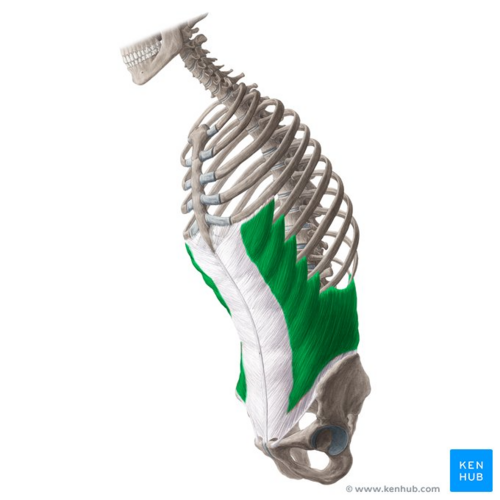External Abdominal Oblique
Original Editor - Khloud Shreif
Top Contributors - Khloud Shreif, Lucinda hampton, Joao Costa and Kim Jackson
Introduction[edit | edit source]
The external oblique muscle is one of the outermost abdominal muscles, extending from the lower half of the ribs around and down to the pelvis. Together, the external oblique muscles cover the sides of the abdominal area, being large and sitting on the top surface of the abdomen right below the subcutaneous fat and skin. Internal obliques are underneath the external obliques on each side of the trunk.
Image: External abdominal oblique muscle (highlighted in green) - anterolateral view[1]
Function[edit | edit source]
The external obliques on either side:
- Help rotate the trunk
- Bilateral contraction of EO along with rectus abdominis and internal oblique flexes the trunk by drawing the pubis towards the xiphoid (like in crunches or sit-ups)[2]
- Stabilizing the core
- Help pull the chest, as a whole, downwards, which compresses the abdominal cavity.
- Assisting with forced expiration in breathing
- Assist with bending from side to side
As the EO contributes to a variety of trunk movements, strain or injury to the muscle can be debilitating, including movements that do not directly use the muscle eg ambulatory motions such as walking or running, which cause movements in the torso[3].
Origin[edit | edit source]
It originates from the external surface of the lower eight ribs 5-12.
Insertion[edit | edit source]
The most posterior fibers directed vertically and other fibers anteromedially.
The EO continues as an aponeurosis at midclavicular line superior and spinoumblical line inferiority, by which inserts into the linea alba, the anterior half of iliac crest and the pubic tubercle.
Nerve[edit | edit source]
The upper two-third of external abdominal oblique supplied by lower intercostal nerves T7-T11 and subcostal nerve T12.
The lower third supplied by the iliohypogastricL1 from lumbar plexus.
Artery[edit | edit source]
Upper 2/3 receives blood supply from branches of lower posterior intercostal and subcostal arteries, lower 1/3 from deep circumflex iliac artery.[4]
Clinical Relevance[edit | edit source]
Bilateral muscle weakness decreases the ability of trunk flexion, and you can see anterior pelvic tilting from standing position in cases of bilateral weakness.
Trigger points: abdominal obliques may develop trigger points due to emotional stress, extra load during exercises, or even new exercise, due to incision, direct trauma, or secondary due to other visceral pathology. The most common sites for obliques trigger points:
- Lateral lower quadrant of the abdominal wall near to ASIS and refer pain diagonally across the abdomen, groin and genitalia.
- Below and lateral to the xyphoid process of the sternum with few inches refer pain to lower chest and upper abdomen, this pain can be mistaken by heartburn[5].
Assessment[edit | edit source]
References[edit | edit source]
- ↑ External abdominal oblique muscle (highlighted in green) - anterolateral view image - © Kenhub https://www.kenhub.com/en/library/anatomy/the-lateral-abdominal-muscles
- ↑ Study.com EO Available:https://study.com/academy/lesson/external-oblique-definition-function-aponeurosis.html (accessed 15.12.2021)
- ↑ Health Line External Oblique Available: (accessed 14.12.2021)
- ↑ https://www.kenhub.com/en/library/anatomy/external-abdominal-oblique-muscle
- ↑ https://www.bluegrassdoctorspt.com/apps/blog/show/42868752
- ↑ Niel Asher Education. Trigger Point Release Therapy - The Obliques. Available from: https://www.youtube.com/watch?v=_WoYZ6-1CqU[last accessed 2/5/2020]
- ↑ MMT Manual muscle test internal and external obliques Dr. Bryan - Physical Therapist.. Available from: https://www.youtube.com/watch?v=KAX_CT98yKs[last accessed 2/5/2020]







